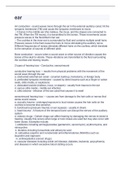Exam (elaborations)
Ear question and answers graded A+
Air conduction sound waves move through the air in the external auditory canal, hit the tympanic membrane (TM) and cause the tympanic membrane to move. - 3 bones in the middle ear (the malleus, the incus, and the stapes) are connected to the TM. When the TM moves, it is transmitted to the bone...
[Show more]



